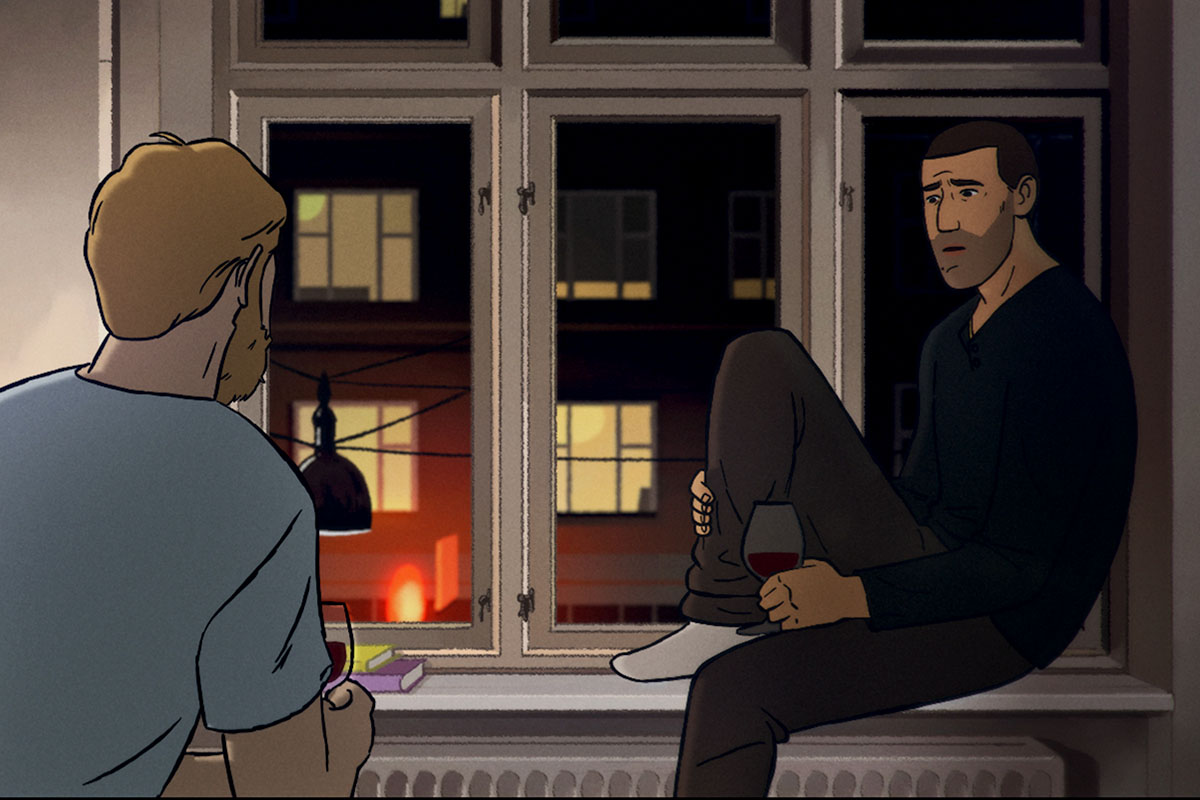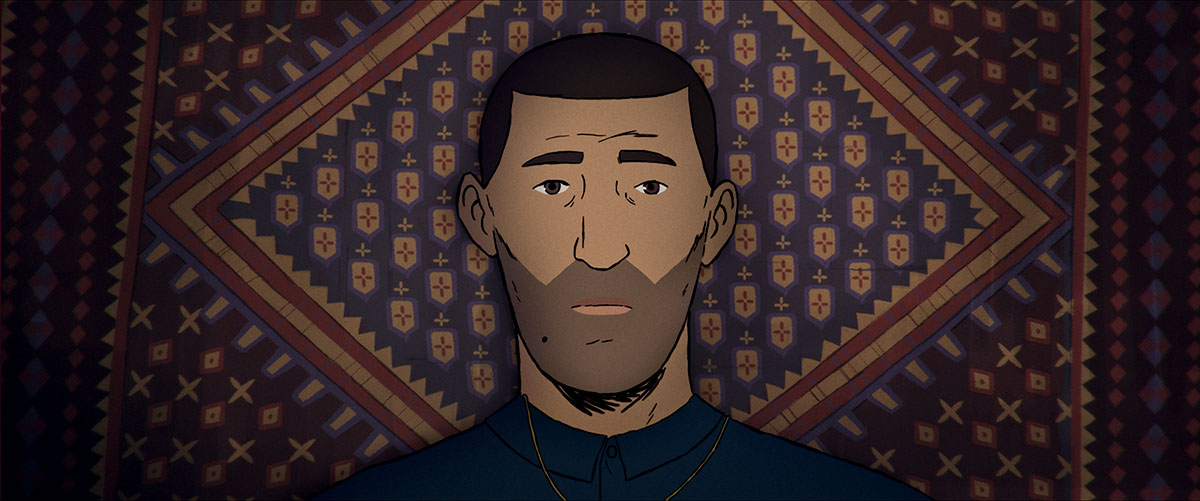
At the end of August 2021, the images of frantic Afghanis crowding Kabul airport were a stark reminder of the despair with which people flee their homeland in search of a safer future. The news unfortunately continues to provide us with a daily litany of tragic images: Haitian refugees rebuffed with whips at the border, North Africans shipwrecked off the tiny island of Lampedusa, or Kurdish women and children drowning in the frigid waters of the English Channel in the hopes of reaching more hospitable shores. For many refugees, each stage of their fraught journey threatens to be their last.
Flee, the new documentary by Jonas Poher Rasmussen and the winner of the 2021 Sundance World Cinema Grand Jury Prize for Documentary and the Best Documentary Prize at Gotham Awards 2021, explores Amin Nawabi’s perilous voyage to freedom as an Afghani teenager, and the harsh aftermath of family separation, dislocation and displacement.
The director met the protagonist, Amin (a pseudonym), over 25 years ago, when they were both 15 and would wait at the same bus stop to go to school, in Denmark. Rasmussen recalls, “I’ve always been curious about his story ever since he arrived in my hometown, but he just didn’t want to talk about it. But the curiosity was always there. I have a background in radio; 15 years ago I asked if I could do a radio documentary about his story, and he said no, that he wasn’t ready. But he knew that he would have to tell it at some point.”
Years later, the idea of recounting the story took on a new shape, when Rasmussen was invited to a “workshop in Denmark called AniDocs, where they combine animators and documentary filmmakers to develop ideas for animated docs. And I thought maybe I would tell [the story]. A lot of the story takes place in the past, so I thought maybe [animation] was a good way to go back in the past. I asked [Amin] again if he would want to tell his story and make it into an animated doc. And he said yes and was very intrigued because with animation we could make him anonymous, which I think was the biggest obstacle for him to share his story. This was the very first time he told his life trauma, and the thought of being public with that was really troubling for him. The fact that we made it with animation really helped open him up. Because the story is really about memory and trauma, and with animation, it enabled us to be more expressive. So at times when he had a hard time remembering something, or something he was talking about was very traumatic, we could go more into the emotion and show the emotional landscape.”
In the film, disturbing events in Amin’s life take on an impressionistic quality, with the animation becoming looser and less defined. Like the seminal Waltz with Bashir (Ari Folman’s personal reckoning with his memories as a soldier in the 1982 Lebanon War), the documentary tackles the challenges of accessing painful and harrowing memories, and how memory itself is often distorted by one’s experience and emotional psyche. Rasmussen acknowledges, “Waltz with Bashir showed me that this could be done. And then there were three Swedish short films—Hidden, Sharaf and Slaves—that are all based on refugee testimony. I really liked how the documentary voice elevated the animation and made it feel stronger and more present.”

Rasmussen interviewed Amin about 20 times during the span of three to four years “because he would slowly open up. In the beginning he said, ‘I can’t talk about this yet.’ When he started to open up, he started to get new memories. Sometimes I would do an interview, and then I would listen to it and transcribe it and find new questions. So it was really a process of going deeper and deeper into his memories.”
The process, despite recalling vividly horrific experiences, was cathartic for the protagonist. “I think it was more therapeutic than traumatic for him,” Rasmussen explains. “He had decided that he wanted to share his story now; he had carried it within himself for so many years because he was afraid. So he felt it created a distance with everyone around such that he couldn’t feel deeply, he couldn’t really connect to people because he always was afraid to expose himself. So he had decided that he wanted to get it out, to get rid of the story.”
When asked about Amin’s family’s reaction to the documentary, Rasmussen concedes,
“They’ve seen the film. And it’s not an easy watch because a lot of [his] memories are also their memories, and those are traumatic memories. So they don’t enjoy watching the film, but they are really happy the story’s been told and [it’s] out there.”
Unfortunately the story of fleeing one’s homeland is one that keeps repeating itself through the ages. The director had a uniquely personal angle: His ancestors were Jewish refugees who left Russia to escape persecution and pogroms. They sought asylum in Denmark, were denied it, and were sent to Germany—where his grandmother was forced to wear a yellow star—before eventually fleeing to England. So Amin’s story is sadly more universal than people realize. “It’s the story of thousands and thousands of Afghans who had almost identical stories,” Rasmussen maintains. “And now a human stage has been given to refugees to represent a big mass of refugees out there.”
When Rasmussen began filming six and a half years ago, migration from war-torn countries was not at the forefront of world events. He points out, “When we started the project, that was before the refugee crisis in 2015 and then again with Afghanistan now. So the project and the perspective changed throughout the process of making the film. The political rhetoric in Denmark was becoming more and more harsh, so I wanted to address that. But then, the refugee crisis came in 2015, and it really became even more prominent. And with Afghanistan now, it’s sadly relevant in a way that I couldn’t have imagined.”
The animation, which occasionally gives way to archival footage of Afghanistan in the 1980s or Soviet-era Moscow, is very realistic. Even though Rasmussen just used the audio, he filmed all his interviews with Amin: “We kind of used that as a reference, and the [animation] team had access to all the materials. The animation director could always go through the material and find little reference points and see how his face would look—little things that were related to the animation.”
The editing process was entirely different: Instead of culling from hours of vérité footage, everything had to be recreated. As Rasmussen explains, “It’s very different in the editing room, You wish for a certain shot, and you can really build a scene the way you want it. [Typically] you come home from a shoot, you have the material and then you shape the material that you got. And here it’s a little bit the other way around, which was an amazing experience for me, to really precisely shape a film.”

The editing was moved to the front rather than at the end of the film: “We did the [master assembly], which was just sound with storyboards. And in the beginning, because of knowledge of reenactments, I wrote dialogue for the different scenes, and then I would do the voices myself, to express all the characters. I filmed a total radio documentary where I birthed all the different characters in the film except, of course, the original interview.”
The documentary, Denmark’s official entry for Best International Feature Film for the 2022 Academy Awards, is recounted in Danish but features other languages, such as Russian and Afghani. Casting the actors to voice certain scenes was complicated yet rewarding. “We don’t have a lot of Afghan actors in Denmark,” Rasmussen attests. “So it was about going into the Afghan community and finding people who would be willing to do the voices. It was a very touching experience, actually, because all of them had similar experiences as Amin, or their parents have had the same experiences. So they started to be moved as well, in the process of recording all these voices. And they brought so much to the screen; you could tell that they brought their own story with them, and it kind of showed in the voices. [At one point], this girl came in for the casting, and I asked her to do a couple of lines and then I asked her if she wanted to do something else. She said, ‘I have this song I’d like to sing.’ She sang this beautiful song that almost all Afghans know, about the pain of the country and how much it’s endured and how it’s breaking down. We put it in the film and when they leave Afghanistan, you hear that song. It was a very rewarding experience, and I think the film gained lots from having all these local Afghans coming in.”
One of the most salient aspects of the film is how the ordeal of being a refugee haunts the present, in terms of human interaction. Amin’s precarious asylum is based on his orphaned status, and this necessary lie haunts him, stunting his intimacy with friends and loved ones and possibly derailing his future. “I think when your whole life was uprooted and you need to rethink, you take your precautions,” Rasmussen explains.
In making the film, the director shares, “I learned how much home means to me, how important it is to have a place where you feel safe. But what I also learned was how much people carry around that you can’t see. I’ve known him for 25 years, and of course I could sense that there were some things that he couldn’t talk about, but I didn’t at all realize how affected he was by this story. Every day of his life, he’s carried this around, and it’s affected everything he did. I really learned that people can carry things around that you don’t see—and that was my biggest revelation: To see someone, who was so well functioning, but in fact was really hurting as well.”
Flee, which opened in theaters December 3, is distributed by NEON.
Darianna Cardilli is a Los Angeles-based documentary filmmaker and editor. Her work has aired on Bravo, A&E, AMC and The History Channel. She is currently editing an Ondi Timoner-directed documentary on crypto currency. Darianna can be reached at www.darianna.com.




